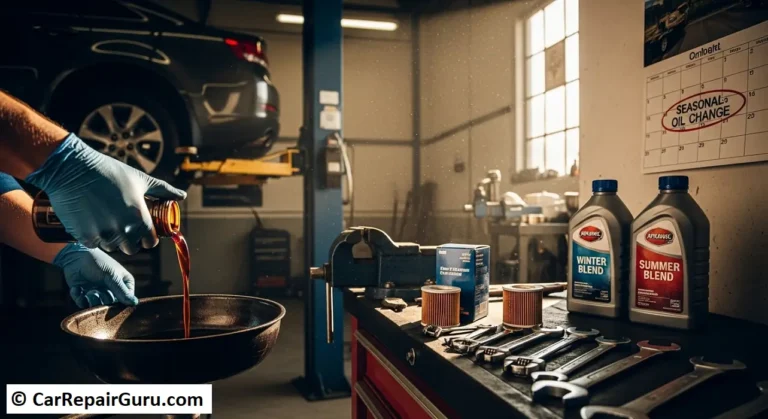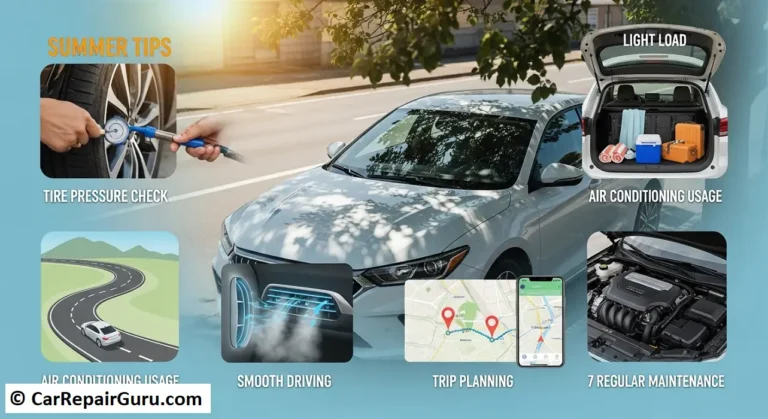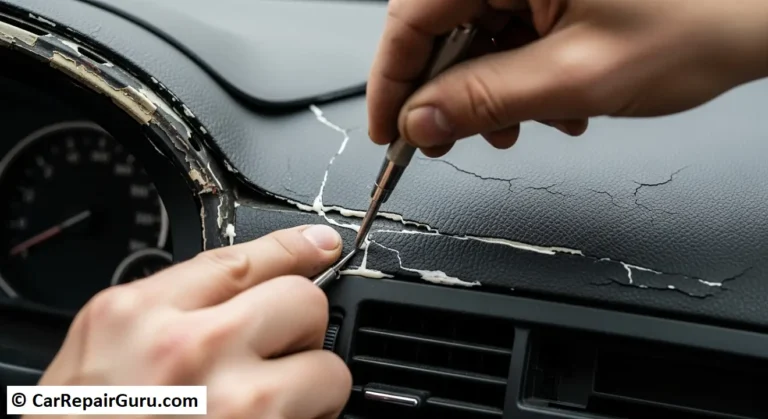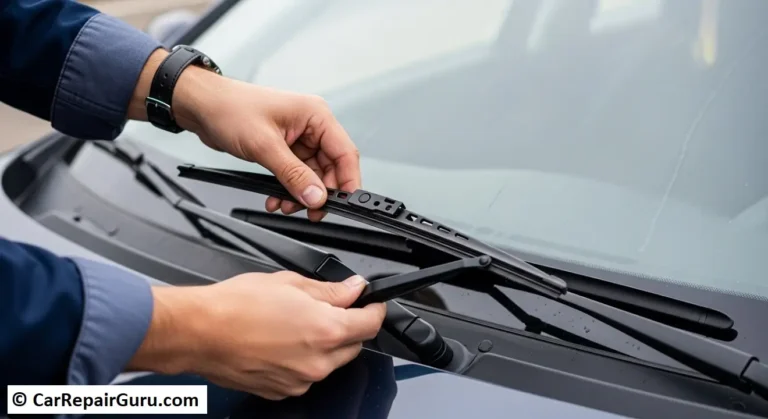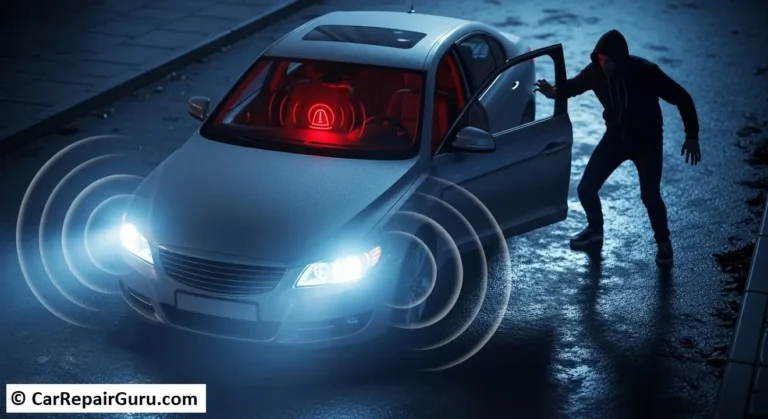
There’s nothing worse than getting caught in a sudden downpour, flicking on your wipers, and being met with a smeared, streaky mess. That blurry view isn’t just annoying; it’s a serious safety hazard.
Many people put off this simple task, thinking it’s complicated or requires a trip to the mechanic. But here’s the secret: changing your own wiper blades is one of the easiest, fastest, and most satisfying DIY car maintenance jobs you can do. You don’t need special tools, and you can get it done in your driveway in about five minutes.
This guide will walk you through everything you need to know. We’ll cover the telltale signs of bad wiper blades, how to pick the right replacements, and a simple step-by-step process for how to install wiper blades like a pro. Let’s clear things up!
When to Change Wiper Blades – 5 Telltale Signs
As a general rule, you should plan to replace your wiper blades every 6 to 12 months. However, your climate and how often you use them play a huge role. Instead of just following the calendar, let your wipers tell you when they’re ready. Here are the five key signs it’s time for a change:
1. Streaking or Smearing: This is the most common sign. If your blades leave behind lines, film, or streaks of water, the rubber edge has likely worn down, cracked, or become hardened.
2. Skipping or Chattering: Does your wiper blade bounce and skip across the windshield instead of gliding smoothly? This chattering sound means the blade is no longer flexible enough to make consistent contact with the glass.
3. Squeaking or Noisy Wipers: While a dirty windshield can cause noise, persistent squeaking is often a sign that the rubber has hardened with age and exposure to the sun.
4. Cracked or Damaged Rubber: Take a moment to lift the wiper arm and physically inspect the rubber blade. If you see any splits, tears, or pieces of rubber flaking off, its clearing ability is severely compromised.
5. Bent Wiper Frame: The frame is the structure that holds the rubber blade. If it’s bent or damaged from heavy ice or an automatic car wash, it won’t apply even pressure, leaving large uncleared patches on your windshield.
Before You Begin – Getting the Right Wiper Blades

Before you can swap out the old, you need to have the new ones ready. Buying the right wiper blades is a simple but crucial step.
How to Find the Right Wiper Blade Size
The most common mistake people make is buying the wrong size. Your driver’s side and passenger’s side blades are often different lengths. Here are three foolproof ways to figure out what size wiper blades do I need:
- Check Your Owner’s Manual: This is the most reliable source. Your vehicle’s manual will list the exact lengths required for the front and rear wipers.
- Measure the Old Blades: No manual? No problem. Grab a tape measure and measure each blade from end to end. Jot down the lengths for the driver, passenger, and (if applicable) rear wiper.
- Use an In-Store or Online Fitment Guide: Nearly every auto parts store has a lookup tool—either a physical book in the aisle or a computer terminal. You can also find these guides online. Simply enter your car’s year, make, and model, and it will tell you the exact sizes you need.
Choosing the Right Type of Wiper Blade
You’ll see a few different styles on the shelf. Here’s a quick breakdown of what makes them different:
- Conventional Blades: These are the old-school, traditional blades with an exposed metal frame that uses several pressure points. They are the most affordable option.
- Beam Blades: These modern blades are made of solid rubber and have no external frame. Their built-in spoiler creates a sleek look and provides uniform pressure across the entire blade for a superior, streak-free wipe. They are excellent in icy and snowy conditions.
- Hybrid Blades: As the name suggests, these combine the best of both worlds. They have the sturdy, multi-point structure of a conventional blade but are enclosed in a protective, aerodynamic shell like a beam blade.
Step-by-Step Guide – How to Change Your Wiper Blades
Alright, you’ve got your new blades. Now for the easy part. Let’s get them installed.
Step 1 – Prepare Your Windshield and Wiper Arm
Lift the wiper arm up and away from the windshield. It should pivot at the base and stay propped up on its own, pointing toward the sky.
Pro Tip (and a crucial one): Place a folded towel or a thick piece of cardboard on your windshield where the arm would rest. If the spring-loaded metal arm accidentally snaps back without a blade on it, it can easily crack or shatter your windshield. This simple step prevents a very expensive mistake.
Step 2 – Remove the Old Wiper Blade
Look closely at where the blade connects to the metal arm. The vast majority of cars use a “J-hook” connector. You will see a small plastic tab or button at this connection point.
- Press or squeeze this tab to release the lock.
- With the tab pressed, firmly push the old wiper blade down along the arm, away from the hook. It will slide right off.
Step 3 – Install the New Wiper Blade
Grab your new wiper blade. Make sure any protective plastic covering on the rubber is removed.
- Orient the new blade the same way the old one came off.
- Slide the J-hook on the wiper arm through the corresponding opening on the new blade’s connector.
- Pull the wiper blade up firmly into the hook until you hear a satisfying “click.”
- That click is your confirmation that the blade is securely locked in place. Give it a gentle tug to be certain it won’t come loose.
Step 4 – Gently Lower the Wiper Arm
With the new blade securely attached, carefully lower the wiper arm back down onto the windshield. You can now remove the towel. Repeat this process for the other side.
Step 5 – Test Your New Wipers
Don’t wait for the next storm! Turn on your car, spray some windshield washer fluid, and run the wipers for a few cycles. They should glide smoothly and silently, leaving a perfectly clear view behind.
Don’t Forget the Back! How to Change a Rear Wiper Blade
If your vehicle has a rear wiper, don’t neglect it! Changing a rear wiper blade is just as important for visibility. The process is usually even simpler, though the mounting style can be different. Often, the entire blade-and-arm assembly lifts up, and the old blade simply unclips or pulls straight off. Your new rear wiper will come with instructions specific to its design.
Pro Tips – How to Make Your Wiper Blades Last Longer
Want to get the most out of your new blades? Proper wiper blade maintenance goes a long way.
- Clean Your Blades: Once a month, wipe the rubber edge with a paper towel dampened with windshield washer fluid to remove grit and grime.
- Never Run Wipers on a Dry Windshield: This causes friction that can damage the delicate rubber edge. Always use washer fluid first.
- De-Ice Before You Wipe: In the winter, use an ice scraper or your car’s defroster to clear ice and snow. Using your wipers as an ice scraper will destroy them.
- Park in the Shade: Over time, the sun’s UV rays break down the rubber. Parking in a garage or shady spot can extend their life.
Common Mistakes to Avoid When Changing Wiper Blades
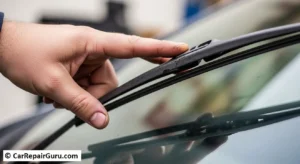
This job is simple, but a few common pitfalls can trip you up. Avoid these common wiper blade mistakes:
- Buying the Wrong Size: It bears repeating—double-check your sizes! A blade that’s too long can hit the edge of your windshield, while one that’s too short will leave large uncleared areas.
- Letting the Metal Arm Snap Back: This is the most costly mistake. Always use a towel on the glass for protection. A new windshield costs hundreds of dollars; a new set of wipers costs about $40.
- Not Hearing the “Click”: If the new blade isn’t fully locked on, it can fly off while you’re driving down the highway in a rainstorm—a terrifying and dangerous situation. Always give it a tug to be sure it’s secure.
- Installing the Blade Upside Down: Some blades are designed to be aerodynamic. If you install one backward, it might not make proper contact with the glass at higher speeds.
When to See a Professional
While changing the blades is a DIY job, sometimes the problem isn’t the blade itself. If you install brand-new wipers and still have issues, it’s time to see a mechanic. Look out for these symptoms:
- The Wiper Arm Isn’t Applying Enough Pressure: If a new blade is still skipping or missing huge patches of the windshield, the spring in the metal wiper arm may be weak and need replacement.
- Wipers are Slow, Erratic, or Won’t Turn On: This points to an issue with the wiper motor or the vehicle’s electrical system.
- The Wiper Arm is Loose or Stripped: If the arm is wobbly at the base where it connects to the car, it won’t move properly and needs to be repaired.
- The Wipers Move Out of Sync: This usually indicates that the wiper linkage—the mechanism under the plastic cowl at the base of your windshield—is bent or broken.
Conclusion – Enjoy a Clear and Safe View
See? That wasn’t so hard. You’ve successfully tackled a key piece of car maintenance that directly impacts your safety on the road. By knowing when to replace your blades and how to do it yourself, you’ve saved time, money, and the headache of driving with a blurry windshield.
Now that you have the knowledge, check your wiper blades today! If you see any of the signs of wear, follow this guide for a quick and easy replacement. Drive safely
Frequently Asked Questions (FAQ)
What size wiper blades do I need?
The best way to find the correct size is by checking your owner’s manual. You can also measure your current blades with a tape measure or use an online fitment guide from an auto parts retailer by entering your vehicle’s year, make, and model.
Are expensive wiper blades worth it?
Often, yes. Premium beam and hybrid blades typically last longer, perform better in all weather conditions (especially snow and ice), and provide a more consistent, streak-free wipe than basic conventional blades. They are often considered the best wiper blades for overall performance and longevity.
Can I just replace the rubber insert instead of the whole blade?
While it is possible to buy just the rubber refills for some blades, it’s often a difficult and finicky process. For most people, replacing the entire wiper blade assembly is much faster, easier, and ensures the frame is also in good working condition.
How often should you change wiper blades?
You should replace them every 6 to 12 months, or as soon as you notice any signs of wear like streaking, chattering, or cracking rubber.
